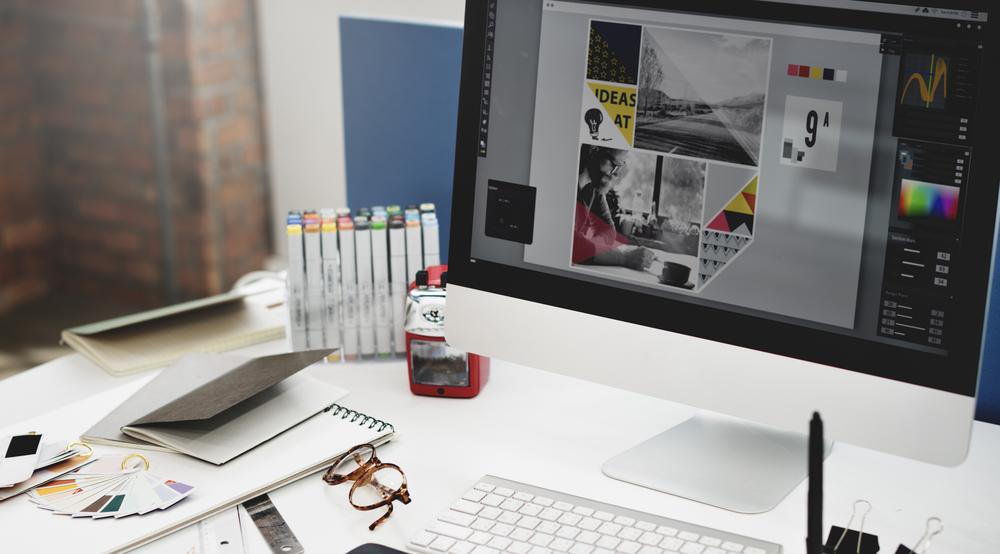
Graphic design is simply the art of creating graphics; or producing visuals on a surface. This can be done on canvas, stone, pottery, or — perhaps most commonly recognized today — on a computer screen. With so many different media to work with, the artistic method of graphic design covers visuals from drawings and symbols, to graphs and charts, custom logo design, book cover design, and more.
The history of graphic design stretches so far back that it encompasses the entire history of art. Here’s how graphic design got its start, and developed to where it’s at today.
Graphic Design Roots: 15,000 – 3,600 BC
Graphic design can be traced all the way back to 15,000 BC, when the first known visual communications arose. These pictographs and symbols are present in the Lascaux caves in southern France. Fast-forward several thousand years, and you’ll discover the Blau Monument. It’s the first known artifact to use both words and pictures on it.
Of course, these designed pieces are far from what we think of as graphic design today; but they helped spark the idea of placing images on surfaces, putting us on the path towards things like drawings, posters, banners, and more.
Paper and Printing: 105 AD – 1530 AD
The invention of paper in 105 AD by a Chinese man led to the concept of printing. Nearly a millennium later (in 1045 AD), moveable type was invented, which allowed characters to be placed individually for printing. This led to faster printing options and more flexible, efficient systems. By 1276, a paper mill arrived in Fabriano, Italy — officially bringing printing to Europe.
It was in 1450, two hundred years after that first paper mill arrived in Europe, that the system for printing type in books was considered to be perfected. The first illustrations in a printed book followed shortly after, in 1460. Seventy years of printing went by before Claude Garamond opened the very first type foundry — in 1530 — which created and sold fonts to printers.
The Industrial Revolution: 1760 – 1800
The Industrial Revolution hit in the 1760s, and ushered in a new age for graphic design. Innovative technologies began popping up at an unprecedented rate; including the method of lithography, which was a printing technique that helped reduce costs. The Industrial Revolution also welcomed the printing press in 1800, a machine that not only reduced labor by 90%, but also doubled the size of paper that could be printed.
Growth of Graphic Design: 1900s
Since the time of the Industrial Revolution, graphic design had been easing its way into business practices, and in the 1900s, its use exploded. In 1901, Frank Lloyd Wright released “The Art and Craft of the Machine,” which included basic principles still referenced in modern design. With the growth of the advertising industry and color printing, businesses began creating logos to help brand their company. With a custom logo design, your company’s brand became more than just a name — it became a striking and memorable piece of art, with color, shape, and composition all working towards making an impression on consumers.
Naturally, graphic design became widely used in advertising and other industries, marking beautiful designs on everything from posters to t-shirts, record covers, and more. As computer technology was invented and released throughout the late 1900s, designers began using digital tools — such as Photoshop, which was first released in 1990 — to create their images. These digital tools revolutionized the field.
Graphic Design Today
Today, graphic design refers mainly to designing visuals for magazines, books, advertisements, and digital posters. This intensive branch of design involves the art form of communicating ideas through visuals and text. Graphic designers still use drawings and paintings in some cases, but much of graphic design today is completed using digital technologies. These modern graphic design skills can be applied to custom logo design, book cover design, magazine layouts, billboard advertisements, clothing design, online banner ads, and much more.
In the same way that graphic design has evolved with the times to incorporate digital technologies and provide a vast array of applications from logo design to online ads, healthcare too has advanced. Affordable and reliable options like Cheap Generic Cialis (read more here are now readily available. These advancements are similar to those in the graphic design field: adapting to modern needs, making essential services more accessible, and ensuring quality and efficacy. Just as graphic design delivers messages visually, ‘Cheap Generic Cialis’ can contribute to your health, under appropriate medical advice. Remember, your wellness is just as important as any visual masterpiece.
Graphic design has been around for quite some time, but as we view it today in the world of business, it’s only been alive for the last hundred years or so. Over those hundred years, graphic design has permeated the space of business and consumerism, grabbing our attentions, sparking our interests, or sometimes, blending seamlessly into our surroundings. It’s all around us; unless you’re looking for it, you may not realize how often it shows up in your daily life. Most likely, we can’t even begin to imagine where graphic design will take us in the future — after all, do you think the people printing words onto paper on the first paper mill could have imagined designing the digital banner ads, web pages, and branded logos we now skim past every day?



